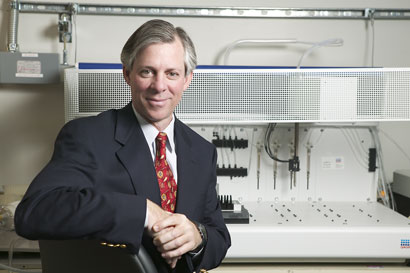|
Robbins
to lead Institute for Cardiovascular Medicine
By MITZI BAKER
As the No. 1 killer of Americans, heart disease requires an
innovative and well-coordinated strike from the medical profession.
Through development of improved diagnostics, preventive strategies
and high-tech treatments, Robert Robbins, MD, will lead the charge
as director of the new Stanford Institute of Cardiovascular
Medicine.
The institute will foster and expand upon ongoing research, from
the genetics and development of cardiovascular diseases to novel
techniques for transplantation and restoring damaged heart
tissue.
“Cardiovascular diseases are an important health problem for
society,” said Robbins, associate professor of cardiothoracic
surgery and director of the heart, heart-lung and lung transplant
program. “We need new strategies for eliminating
them.”
For example, he said while heart transplantation has been a miracle
savior for some, there are just too few available donor hearts --
about 2,000 annually -- to supply the 5 million or so Americans
with end-stage heart disease. “Treating congestive heart
failure with cardiac transplantation is analogous to treating
poverty with lottery tickets,” he said.

As director of the Institute for
Cardiovascular Medicine, Bobby Robbins, shown in a lab in the Falk
Cardiovascular Research Building, will lead researchers toward
discoveries of wide-ranging treatments for heart disease.
Photo: Visual Art Services
A number of ailments, including congenital heart diseases and
dysfunction of the coronary arteries, aorta, valves and
vasculature, end up at the same place: heart failure, which results
in death or disability.
Although there have been many advances in treating cardiovascular
disease in recent years, Robbins said an enormous amount of work
remains to be done. Heart disease is the top killer of Americans,
with one in four Americans affected, at a cost of more than $150
billion annually.
“The rationale for establishing this institute is that
cardiovascular disease is a major problem that needs to be
addressed. I think that the strength of the Stanford Institute for
Cardiovascular Medicine will be to leverage our position in novel
discovery and innovation and translating this new knowledge into
the care of patients,” said Robbins, who has been a faculty
member at Stanford since 1993. “My vision for the institute
is incorporated by its mission statement, which is the prevention,
treatment and elimination of cardiovascular diseases.”
Robbins is a cardiac surgeon with expertise in heart
transplantation as well as treating complex cardiac diseases. He
also heads a research laboratory that embodies what the institute
aims to do on a large scale: collaboration, integration of basic
and clinical research and education of students and young
physicians.
His current clinical research projects include improving the
process of heart transplantation through the genetic manipulation
of donor tissue and by developing devices that allow bypass
surgeries to be performed through a very small incision. Robbins is
also active in basic research, including the use of stem cells and
growth factors to repair heart tissue damaged by a heart
attack.
The Institute for Cardiovascular Medicine is the third of the four
Stanford Institutes of Medicine to have a director named. The
Institute for Cancer/Stem Cell Biology and Medicine is directed by
Irv Weissman, MD, the Karel and Avice Beekhuis Professor of Cancer
Biology, and the Neurosciences Institute is directed by Bill
Mobley, MD, the John E. Cahill Family Professor. Along with the
Institute for Immunity, Transplantation and Infectious Diseases,
which does not yet have a director, these four institutes focus on
translating discoveries from the bench to the bedside, and offer a
linkage between the basic and clinical science faculty along with
connections to clinical programs at Stanford Hospital & Clinics
and Lucile Packard Children’s Hospital.
The self-stated “grand challenge” of the heart
institute is “the improvement in the cardiovascular health of
patients through the translation of innovative
discoveries.”
Part of the way the institute aims to achieve the challenge, said
Robbins, is through the integration of five existing cardiovascular
centers that cover clinical, laboratory and population studies and
cardiovascular bioengineering.
One of the primary goals of the institute, Robbins said, is in
reaching out: to young researchers and physicians through
educational programs; to other departments at the School of
Medicine and on the main campus -- already 136 faculty from 25
departments have expressed interest in being affiliated with the
institute; and to the community beyond the university, by taking
advantage of Stanford’s Silicon Valley home and forging
collaborations with pharmaceutical, biotech and medical device
companies to help bring laboratory findings to the patient.
Robbins pointed out that four of the Wall Street
Journal’s “Ten major medical advances you’re
likely to see in the coming year” for 2004 encompass heart
health. Robbins said that through the wide-ranging collaborations
exploring new territory such as the genetics behind heart disease,
the development of cardiac-assist devices and new methods of
repairing heart damage, many major medical advances will be made by
the new institute.

|

